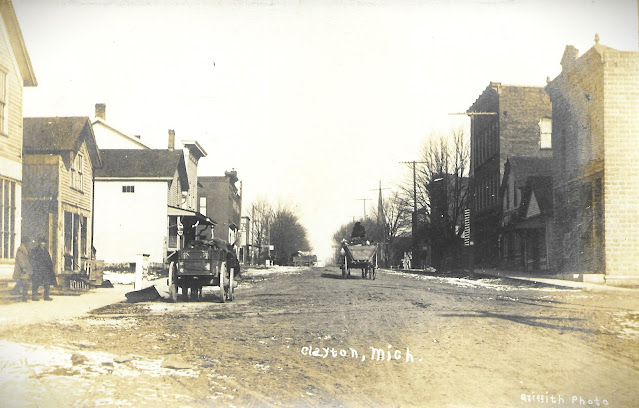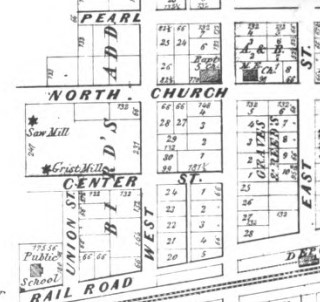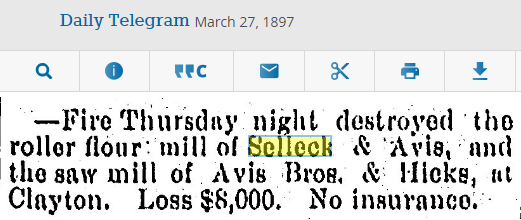 |
| Griffith photo postcard circa 1907, forty years after the article below was written--showing the earliest frame buildings as well as the later ones built of brick. |
1868, Dec. 15 Adrian
Daily Times and Expositor
------------
The Location—A Little of the Past, Present and Future
The Citizens and What they are Doing.
------------
Prospecting and sight seeing, when the snow is six inches
deep and “going,” is not the most pleasant occupation, yet with a determination
to see and find out for one’s self, it is possible, even under such
circumstances, to make such work pleasant.
Recently the winter, in pursuance of a week already begun as indicated
by the description of two of our county villages, given in these columns three
weeks ago, paid the village of Clayton a flying visit, the result of which will
be given in the following cursory history and description of that village.
CLAYTON
Is located on the M. S. & N. I. railroad on the town
line separating the two towns of Dover and Hudson, the dividing line (of the)
village which lies in about equal parts on the opposite sides. It is 11 ½ miles by rail from Adrian, a
little further by road, and 6 miles from Hudson. The location is pleasant, being on what is
known as the ridge land running North and South and having its highest
elevation in Hillsdale county, being there the highest land in the Southern
part of the State. This ridge is the
water shed, the water running East or West from its crest line. The soil in the immediate vicinity of Clayton
is a kind of composite of loam and clay and is excellently adapted to wheat and
barley, the yield of which is large.
EARLY HISTORY
This village, as everything else, “had its beginning in
time,” and that time about twenty-eight years ago, the survey of the original
plat having been made in the winter of 1839-40 on the lands of R. E. Bird
Esq. The name was given by John M. Bird
Esq. in honor of John M. Clayton the distinguished Delaware Senator. The first family that settled in the new
village was that of Mr. Hollis Howe.
Soon after Mr. J. B. Williams came in, Mr. Williams was a carriage and
wagon maker and worked at his trade. The
first store was opened by Mr. R. E. Bird in the year 1840. In 1843 the post office was located in
Clayton. Anson Carter who came in 1844
opened the first blacksmith shop in the place.
These were the men identified with the earlier history of the village,
others came in being mostly of the same class, mechanics and laboring men,
whose occupations and labor were made necessary by the demands of the new
country opening up about them. Situated
as Clayton is, it can never be a large city, its inhabitants have not anticipated
any such thing perhaps but
ITS GROWTH
During the last four or five years has been very
marked. Indeed, to use the language of
some of its citizens, “about all it is, it has become in that time.” The cause of this sudden start in the
prosperity of the place which for so long a time had improved so slowly, is not
well deduced to the minds of the citizens, judging from the different reasons
given in answer to our inquiries on this point.
The most probably explanation is that those owning lands about the
village declined opening them up to the encroachment of the village, had it
never so inclination in that way. But
the barrier fell at last. New lots were
laid out and offered for sale, and were quickly “gobbled” by the citizens and
others who were desirous of becoming citizens.
New buildings have been erected, others are in progress of erection and
taken altogether Clayton has a very healthy look. Its present population is, we should judge,
in the neighborhood of 400, though some of whom we conversed, put it higher,
but we promise to rectify this estimate if on actual count it shall be found
that our figures are too low,
BUSINESS AND BUSINESS MEN
There are three stores which keep a general assortment of
goods. The oldest business house is
perhaps that of R.E. Bird whom we found actively engaged in attending to the
demands of numerous patrons. The next
house in point of age is, if we are right, that of Benedict and Bennett, who
have no particular cause to complain, if the day of our visit was a fair
indication of the usual amount of their trade.
Messrs. Fuller, Rothrock & Co., are “carpet baggers” in the place,
having come in about two months ago, but they seem to be gritty fellows, and we
guess the other business men will have to do by this firm as Brick Pomeroy
wanted the New York papers to do by him, “lay over and make rooms,” for they ”have come to stay.” In addition to the business of the store
proper, this new firm are “running” a tailoring and manufacturing room, as well
as the purchase of grains and farm products generally. Of groceries there are two, one kept by J. C.
Benedict the other by Marcus Curtis.
Messrs. Phillips & Bedell attend to the “hardware” wants of the
Claytonites and all others who may favor them with a call. The business of the firm is under the
immediate charge of Mr. Phillips an energetic and worthy young merchant. Of Blacksmith shops there are three, one in
charge of Martin Bates, one of which Messrs. Losey and Duncan are proprietors
and the other is presided over by Ezra Abbott.
Newman Perkins, Cabinet maker, Upholster and Undertaker has the monopoly
of all business in his line. M. W.
Curtiss provides ornamentation for horses, or in plain English, makes harnesses
while the understandings of the Claytonite are protected from the wet and cold
by the handiwork of G. W. Southwick who makes the best kind of boots and
shoes. Henry Hitchings ministers to one
want of the people by providing them with meats of all kinds which he dresses
with his own hands, and rejoices that he is not above being a good
butcher. S. Cross is proprietor of a
portable steam saw mill which has work enough ahead to keep it going
sometime. Here as elsewhere sickness
sometimes comes, but there are those who are ready and willing to battle with
it, for a consideration, Dr. A. F. Chaffee (Allopath) and Dr. P. W. Gilson
(Botanic). The labors of these gentlemen
are well secceded by D. C. Chase druggist. Messrs. Chandler & Payn are doing quite a
business in the way of buying and shipping poultry eggs and game. The wants of the traveler have been duly
considered, ample provision having been made for them in the erection of a
public house, the “Clayton Exchange,” Messrs. Sayles and Austin, Proprietors. The “Exchange” is a model of its class and
leaves no reasonable want of the traveler unsatisfied. In connection with the House, is a well
stocked Livery Stable. The stage line
running from Calyton to Morenci by way of Medina and Canandaigua, is owned and
controlled by the proprietors of the “Exchange.” The business interests of the village are all
in fair and prospering condition. Some
idea may be gained of the shipment of produce, etc. from Clayton, by the
shipments of four days including the 4th of the present month, for
which we are under obligation to Mr. E. Bates, station agent: Sheep 58, butter 1,365 lbs., poultry 5,783,
eggs 24 bbls., dressed hogs 116, clover seed 3,562 lbs., buckwheat flour 10
bbls., wheat flour 50 bbls., dressed beef 942 lbs.
The Claytonites are a reading people, as the list of papers
taken through their postoffice attests.
The figures, as given to us by the gentlemanly postmaster J. C.
Benedict, show that there are 213 weekly papers taken regularly, besides
periodicals and transient matter.
CHURCHES
The people of this village have no good excuse for being
wicked, which, let it be remembered, we do not charge, since there are three
churches: The Presbyterian, Rev.
Campbell pastor; the Baptist, Rev. Walden pastor, and the Methodist, Rev.
Olmstead pastor. As to the church
buildings, the Baptist denomination have the advantage, having a fine brick
edifice, the other two have frame buildings, though we were informed that the Methodist
people contemplate the erection of a new building, the one they now occupy
being unfitted for the wants of the congregation.
EDUCATIONAL INTERESTS
It is in the matter of school enterprise that the citizens
of this place deserve to be most highly complimented. During the past season a fine two story brick
building 40X60 feet, has been erected in the western skirt of the village, at a
cost of between five and six thousand dollars.
The building is now in process of completion, two rooms having been
fitted up for occupancy on the 7th, at which time the winter term
opened. The building was put up under
contract, by Mr. Aaron Abbott, who is the building genius of Clayton, and the
very man for the place. The school
opened, as stated, under charge of Prof. Drake, who has made a fine reputation
as a teacher in the county as proprietor for several years of “Oak Grove
Academy,” located in Medina. Clayton has
been very fortunate in securing the services of this gentleman. He is ably supported by Miss Juliet Bird, as
assistant, a practiced and successful lady teacher. It is designed to grade the school and make
it all that an enterprise of this character ought to be. From the number of scholars in the village we
should judge that it will be but a short time before the services of another
assistant will be required. When the
school building shall have been finished, the grounds enclosed, and put in
order, Clayton will have just cause to be proud of what she has done in the way
of providing for the mental wants of her little folks.
These are the salient points in the past and present of
Clayton. It appears to be a lively
village, and though some of its people are disposed to grumble that the
progress of their place is not more rapid than it is, there is not a single
reason why they should be discouraged.
The buildings now in contemplation, and almost certain to be built
during the coming season, will add much to the good appearance of the
village. We understand that Mr. Abbott
intends putting up a brick block of business buildings on the ground just north
of the “Exchange.” That will give to the
main street quite a business like appearance, besides enhancing the value of
village property. There is an
improvement that we would recommend to Claytonites. It was suggested by the remark of a farmer
living in the vicinity of the place, who in reply to a query, said he had “been
to Canandaigua to mill.” Why couldn’t
there be a mill at Clayton as well as at Canandaigua? But we are only anticipating what some live
man will carry into execution some day in the near future. Clayton has seen its worst days, it is now
entering on a new and wider existence and though it is not likely to be a Chicago,
it certainly will be a lively go ahead place of which Lenawee county will be
proud.














